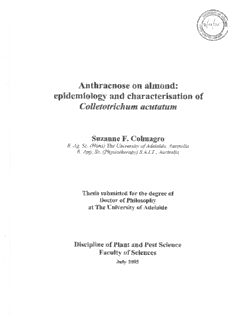
Anthracnose on almond PDF
Preview Anthracnose on almond
I f,' n Anthracnose on almond: epidemiology and characterisation of Colletotrichum øcututum Suzanne F. Colmagro B.Ag. Sc. (Hons) The University of Adelaide, Australia B. App. Sc. (Physiotherapy) S.A.I.T., Australia Thesis submitted for the degree of Doctor of Philosophy at The lJniversity of Adelaide Discipline of Plant and Pest Science Faculty of Sciences July 2005 Atmonl bfossom I lelírøte tfiís tfr¿sis to ntu tutttl., føye (8,04.1941-1-6.11.2002)utfro' ulitft øtt frar fooe ønl aiírønclt u)Øs ø[uøys so proul of mg øcfi.í¿rlem¿n* ønl interutel in ufrat I ans loing. Mt ø løy gou 6y utitfrout tfrinfuU of you. Ako, I uouff [ikg to rem¿mher my A{atr-nø ønl lPoppø Qørtingtonfor a.tt of tfrnir {ooe ønl support in ny formntírte yeørs. I mks yoa øff. Table of Contents Abstract .1 Declaration .lV Aclcrowledgements.. V Abbreviations v11 1 Chapter Introduction 1 2 Chapter Literature revlew.... 4 2.1 Background......... 4 2.I.1 The almond industry 4 2.1.2 Anthracnose disease on almond: history, distribution and economic importance.... 5 2.2 The genus Colletotrichum Corda. 8 2.3 Identification and characterisation of Colletotrichum acutatumby cultural methods 9 2.3.1 Morphologyandculturalcharacteristics 10 2.3.2 Vegetative compatibility group analysis..... 72 2.4 Identification of C. acutatum using molecular methods .13 2.4.1 Immunologicalidentification. .13 2.4.2 DNA-basedidentification ..74 2.5 DNA-based characterisation of fungal plant pathogens ... ..15 2.5.1 Factors and mechanisms responsible for genetic diversity... 15 2.5.2 Development of molecular markers ..t7 2.5.2.1 Restriction Fragment Length Polymorphism analysis........ .18 2.5.2.2 PCR-based methods.... t9 2.5.3 Molecular analysis of C. acuiatum... 24 2.6 Epidemiology of anthracnose on almond.. 2.6.1 The disease cycle 27 2.6.2 Symptoms 29 2.6.3 Cultivarsusceptibility 30 2.6.4 Main source(s) of inoculum....... 30 2.6.5 Pathogenicity ^JJ^ 2.6.6 Environmental factors. 34 2.6.7 Disease management.... 36 2.6.8 Disease developmentmodels... 38 2.7 Summary.... 40 2.8 Research objectives... ....4r 3 Chapter General materials and methods ....42 3.1 Collection and establishment of isolates of C. acutatum.... ....42 3.2 Fungal cultures ....44 3.3 Identification of C. acutatum using PCR ....48 3.3.7 Isolation and purification of fungal DNA ....48 3.3.2 PCRamplification............ 50 3.3.2.1 Identification of C. acutatum using genomic DNA 50 3.3.2.2 Identification of C. acutatum using mycelial extract........ 51 3.3.3 Conclusions 53 3.4 Source and maintenance of potted plants........ 54 3.5 Confirmation of identity of almond cultivars...... 55 3.5.1 PCR using anchored dinucleotide primers... 56 3.5.2 PCR using ,S-allele primers. 57 3.5.3 Conclusions 59 4 Chapter Morphological and cultural variation of Colletotrichum spp. .......... 60 4.1 Introduction.... 60 4.2 Materials and methods 6l 4.2.I Morphologicalvariation.. 6I 4.2.1.1 Colony characteristics and conidial morphology. 6t 4.2.1.2 Statistical analysis..... 64 4.2.2 Growth rate at arcrrge of temperatures. 66 4.3 Results 67 4.3.1 Morphologicalvariation.... 67 4.3.11 Cultural characteristics. 67 4.3.7.2 Conidial morphology.. 69 4.3.2 Growth rale at àrange of temperatures... 81 4.4 Discussion 86 5 Chapter Genetic variation among Colletotrichum spp. .98 5.1 Introduction 98 5.2 Materials and methods 100 5.2.I PCR amplification...... ...100 5.3 Results... ..102 5.3.1 Genetic variation of C. acutatum. 702 5.4 Discussion....... 108 Chapter 6 Pathogenicity of Colletotrichum spp tt4 6.1 Introduction 7t4 6.2 Materials and methods 115 6.2.1 General rnaterials and methods.. ..115 6.2.2 Pathogenicity on detached leaves ...... .tt7 6.2.2.I Experiment Ll - preliminary .......... 717 6.2.2.2 Experiment L2 - pathogenicity of C. acutatum frorn Australia and Israel t77 6.2.2.3 Experiment L3 - pathogenicity of C. acutatum fromAustralia, Israel and Califomia....... 118 6.2.2.4. Experiment L4 - susceptibility of Price and Nonpareil at different 119 6.2.3 Pathogenicity on detached fi:uit . 719 6.2.3.1 Experiment Fl - preliminary... tt9 6.2.3.2 Experiment F2 - pathogenicity of C. acutatum fromAustralia and Israel t20 6.2.3.3 Experiment F3 - pathogenicity of C. acutatum fromAustralia, Israel and California............... 12l 6.2.3.4 Experiments F4a and F4b - susceptibility of almond cultivars and hybrids to C. acutatum...... .r27 6.2.3.5 Experiment F5 - pathogenicity to almond of C. acutatum ftom almond and other hosts ........ 122 6.2.4 Pathogenicity to almond shoots - preliminary experiment t23 6.3 t24 Results........... 6.3.1 Pathogenicity on detached leaves r24 6.3.1.1 Experiment Ll - preliminary. 124 6.3.r.2 Experiment L2 - pathogenicity of C. acutatum fromAustralia and Israel 6.3.1.3 Experiment L3 - pathogenicity of C. acutatum from Australia, Israel and California........... 125 6.3.7.4 Experiment L4 - susceptibility of Price and Nonpareil at different ...r27 6.3.2 Pathogenicity on detached fruit t28 6.3.2.1 Experiment F1 - preliminary t28 6.3.2.2 Experiment F2 -pathogenicity of C. acutatum from Australia and .t29 Israel 6.3.2.3 Experiment F3 - pathogenicity of C. acutatum from Australia, Israel and Califomia............... 130 6.3.2.4 Experiments F4a and F4b - susceptibility of almond cultivars and hybrids to C. acutatunt............. 6.3.2.5 Experiment F5 - pathogenicity of C. acutatum from almond and other host plants on almond........ t33 6.3.3 Pathogenicity to almond shoots - preliminary experiment ................134 6.4 Discussion ..r37 7 Chapter Epidemiology of anthracnose on almond t45 7.1 Introduction t45 7.2 Materials and methods !47 7.2.1 Disease <levelopment in the field t47 7.2.1.1 Field site .t47 7.2.1.2 Monitoring anthracnose disease 148 7.2.1.3'Weather data collection....... 1.s0 7.2.1.4 Data analysis. 150 7.2.2 Isolation of C. acutatum fromplant material..... t52 7.3 Results... ..153 7.3.1 Disease development in the field 7.3.1.1 Season 2002 1s3 7.3.1.2 Season 2003 . 155 7.3.1.3 Season 2004 .. 159 7.3.I.4 Mummified fruit and disease incidence for all seasons 762 7.3.I.5 Environmental variables and disease development ...164 7.3.2 Isolation of C. acutatum fromplant material .t67 7.4 Discussion 172 7.4.1 Disease development in the field t72 7.4.2 Isolation of C. acutatum fromplant material 178 7.5 t82 Summary. 8 Chapter General Discussion 184 Appendix A (media and reagents) ........ 194 Appendix B... 196 References t97
